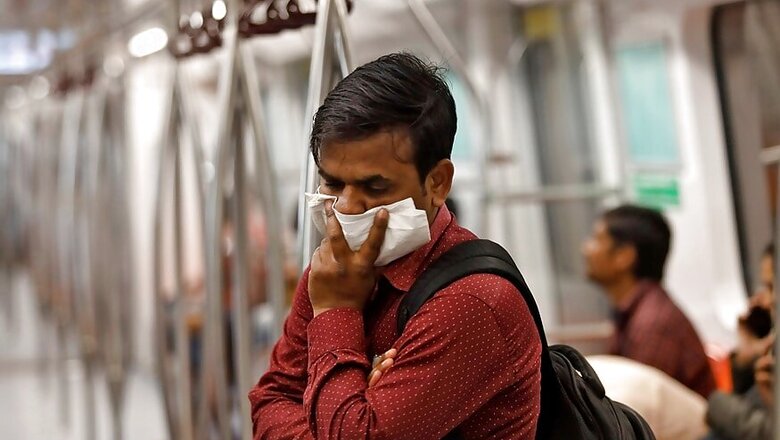
views
The World Health Organization on Monday asked all countries to ramp up their testing programmes as the best way to slow the advance of the coronavirus pandemic.
“We have a simple message to all countries - test, test, test,” WHO Director General Tedros Adhanom Ghebreyesus told a news conference in Geneva, adding that all countries should test all suspected cases. Without testing, cases cannot be isolated and the chain of infection will not be broken, he said.
However, the Indian authorities have taken a diagrammatically opposite approach, instead choosing to restrict coronavirus tests to only those with recent travel history to affected and high-risk countries or those known to have come in contact with confirmed cases and also exhibiting symptoms of the disease.
Restricted Testing Protocol
So if you have a cold, cough or fever and don't have a history of travel to countries that are high-risk at the moment or have not come in contact with travellers, chances are that you will not be tested immediately for coronavirus.
This highly-restricted testing protocol has meant that India has only tested 9,000 people for the virus as of Monday. Compare this to South Korea, which is testing as many as 12,000 people per day. The high amount of testing done by the country, which has fourth-most cases, has been credited with saving lives and reducing the impact of the disease.
While India has lagged in testing suspected cases, the country was one of the first to essentially shut its borders, cancel visas and deny entry to foreigners from high-risk nations. The government has also now started ordering the same kind of restrictions as in the worst-hit nations. Schools, movie theatres, swimming pools, gyms, even offices are being shut. Large public gatherings are being banned.
But these containment measures, as strict as they have been, only work to an extent. In a country as overcrowded as India, some people always slip the net. This has been the case with many people fleeing isolation wards in various states and coming in contact with others, risking community transmission.
In the early stages of an outbreak, contact tracing, isolation, and individual quarantines are regularly deployed to contain the spread of a disease.
But experts point out that these tools are useless if suspected cases of a disease are not tested. And this is a void that the Indian government has failed to fill in time.
Expansion Plans
On Tuesday, the Indian Council of Medical Research (ICMR), the country's apex body on biomedical research, finally announced that the administration has decided to expand the number of labs that can test patients for COVID-19 from the present 72 government facilities.
Another 49 non-ICMR, Ministry of Health, and other government laboratories will also be engaged for testing by the end of this week. This would include the Council of Scientific and Industrial Research, Defence Research and Development Organisation, DBT and government medical colleges.
Apart from this, 51 private labs accredited with the National Accreditation Board of Laboratories will also be roped in for the tests, but they will have to acquire probes on their own and this may take another 7-10 days.
Despite the limited amount of testing done, the ICMR has insisted that there has been no community transmission of COVID-19 in the country.
Community Transmission Risk
“We are in stage 2. We are not in stage 3. There are four stages. Third stage is community transmission which we hope we shouldn’t have,” ICMR director-general Dr Balram Bhargava said at a media briefing on Tuesday.
This claim is backed up by random sampling, rather than expansion of testing to those without travel and contact history.
Dr Bhargava said that a random sampling exercise was done as part of which 1,000 people were tested in February and another 1,000 were tested in the first 15 days of March. All the February samples and the first 500 March samples were negative, the ICMR DG said.
Community transmission is when a patient cannot be traced to a known confirmed case, going undetected. Since India has among the lowest testing rates in the world, around 5 in a million, it cannot be ruled out with certainty.
Nivedita Gupta, ICMR scientist, epidemiology and communicable diseases division, said that low testing has been done “to avoid indiscriminate and futile testing”. “We have to rationalise it somewhere,” she told News18.
ICMR scientists have also said that early testing of asymptomatic people may throw of “false negative” results. This protocol has been adopted despite recent studies suggesting that 80 per cent of the people spreading the disease may not even know they are infected.
Lack of Kits
Part of the reason for the restricted testing method could be the low number of test kits available with the Indian authorities. According to various estimates, India only had 1.5 lakh test kits and lack of any domestically made kits made it entirely reliant on imports.
Thyrocare Technologies Limited, a chain of diagnostic and preventive care laboratories, on Tuesday told News18 that obtaining kits from abroad has been a challenge because of the airlines being in lockdown and travel bans imposed by the government for several nations.
An Indian-developed kit is also a few weeks away at the minimum as the Chennai firm said to be the first to manufacture one in India said getting clearances from government facilities will take at least two to three weeks.
The reasons for this slow response of the Indian industry and the full extent of the difficulties laboratory have faced has remained largely opaque, considering the pace at which some other countries worked after Chinese scientists uploaded a copy of the virus’s genome to an online repository on January 10.
Government scientists now insist that India will scale up its testing kits to a million and orders have been placed with the WHO and Germany. Till then, it will rely mainly on urging people to practice social distancing that shifts the onus of stopping the spread of the virus from the government to the public.



















Comments
0 comment